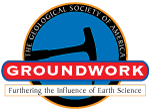Abstract View
Volume 25 Issue 9 (September 2015)
GSA Today
Article, pp. 58–59 | Full Text | PDF (118KB)
 |
| Search GoogleScholar for Search GSA Today |
GROUNDWORK:
The Snowmastodon Project: Cutting-edge science on the blade of a bulldozer
1 U.S. Geological Survey, Denver Federal Center, Box 25046, MS-980, Denver, Colorado 80225, USA
2 Dept. of Earth Sciences, Denver Museum of Nature & Science, 2001 Colorado Blvd., Denver, Colorado 80205, USA
First a Discovery, Then Digging Like Mad
Scalpel. Knife. Shovel. A bulldozer’s blade.
Cutting-edge science happens at a variety of scales, from the individual and intimate to the large-scale and collaborative. The publication of a special issue of Quaternary Research in Nov. 2014 dedicated to the scientific findings of the “Snowmastodon Project” highlights what can be done when natural history museums, governmental agencies, and academic institutions work toward a common goal.
On 14 Oct. 2010, a third-generation bulldozer driver named Jesse Steele was pushing dirt as part of a reservoir expansion project high in the Rocky Mountains at Ziegler Reservoir, just outside Snowmass Village, Colorado, USA. The reservoir was to be enlarged to meet the needs of a growing population and a local ski resort, and up until that point, the work was right on schedule. When Steele pushed up some strange bones along with the usual lake muds, however, it was apparent that everything was about to change.
*Current address: National Museum of Natural History, Smithsonian Institution, Box 37012, MRC 106, Washington, D.C. 20013, USA.
Manuscript received 28 Dec. 2014; accepted 9 Feb. 2015
doi: 10.1130/GSATG240GW.1
